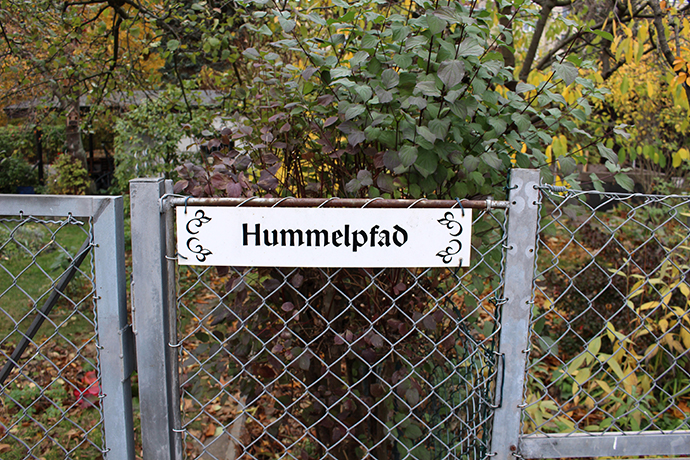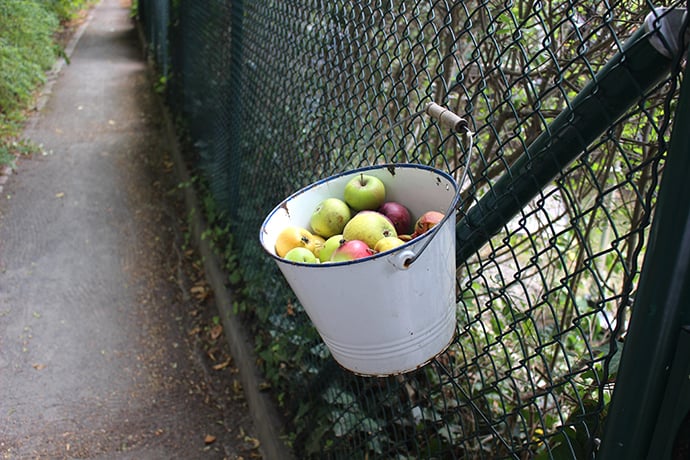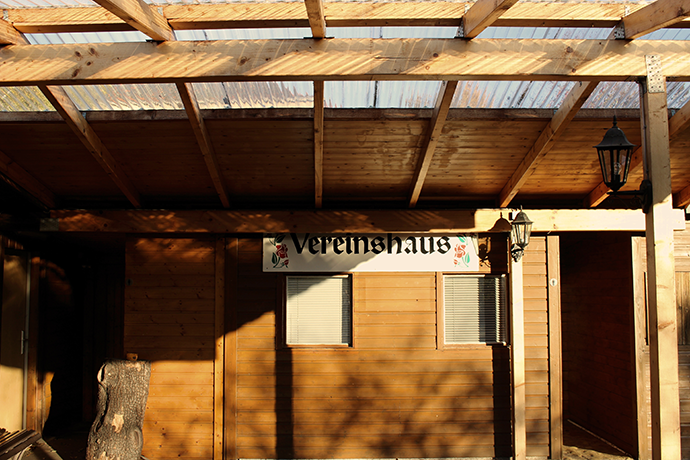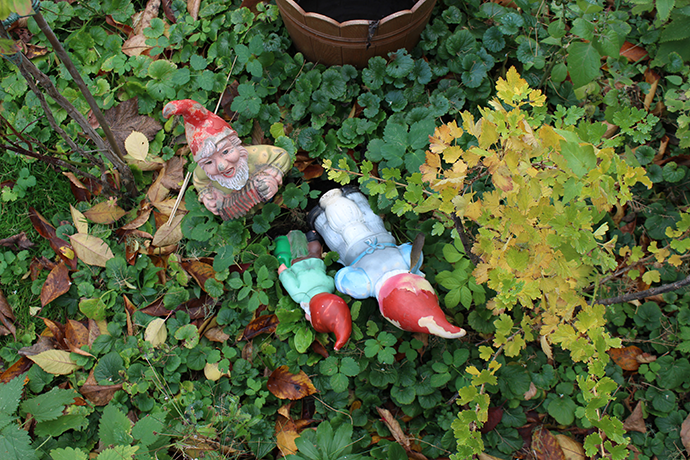Not in My Backyard
Amid Berlin’s affordable housing shortage, urban gardens have been sowing unrest
On the first weekend of November, the Kolonie am Stadtpark I allotment garden in southwest Berlin is busy. Yellow leaves are raked into browning piles and vegetable beds are watered one last time before the pipes are shut off for winter. Gardeners exchange greetings and sip afternoon schnapps. Here and there, families gather outside of their garden sheds, enjoying what threatens to be the last mild Saturday before another season of numbing cold. One shed has a miniature kitchen, couch, chairs, table, and bathroom; the owner’s tools are decoratively shelved in a cabinet outside. Other sheds appear ample enough to serve as cozy second homes.

“Bumblebee Path” in the Kolonie am Stadtpark I. All photographs by Sami Emory.
One of Berlin’s many Kleingärten (literally: small gardens), Kolonie am Stadtpark I is host to 119 plots, comprising just under 291,000 square feet of land, which is tended to by a “colony” of more than 170 gardeners. As in many parts of Europe, these allotments are leased to individuals or families through the government or, less commonly, private landowners, for growing food and for noncommercial gardening; unlike a North American community garden, each lessee maintains their own plot. Surrounding the Kolonie is a park, an international school for the first through thirteenth grades, a town hall, an uneven mix of handsome prewar and boxy, Soviet-style postwar apartment buildings, a Pilates studio, and a handful of the city’s ubiquitous Vietnamese eateries. It would be an ideal neighborhood for developers in any part of the world, but it’s especially prized in a city where the demand for affordable housing has reached an angry pitch.
Kleingärten have been part of the fabric of urban life since the 1800s. Then, they were called Armengärten, or “poor gardens,” where citizens grew their own food in lieu of government support. During the industrial frenzy in the lead-up to World War I, workers’ families flipped unused patches of land for the same purpose, and they soon became a vital cog in the survival mechanism of Berlin’s citizens. This remained the case throughout the Weimar years and into World War II, when the gardens became places of shelter—it’s even said that German Jews and members of the resistance used Kleingärten sheds as hideaways.
The contemporary cult of the Kleingarten is indebted, as are many mainstays of German culture (water cures, wilderness kindergartens, vigorous walking), to a wellness pedagogue. Daniel Gottlob Moritz Schreber was a hard-nosed Leipziger physician who soapboxed for the benefits of physical exercise for children. This was one of his less controversial theories; Schreber also dallied in medieval contraptions built to curb the unattractive habits of youth, like slouching and masturbating. After his death, the Schreber movement championed the physician’s beliefs by encouraging children, and then adults, to reap these benefits with shovel and rake on little plots of leased land. (In many other parts of the country, Kleingärten are known as Schrebergärten.) This attitude is what most Germans bring to their allotment gardening today, in pursuit of well-being, recreation, and escape.

On the other side of the fence, Kleingärten are often seen as little patches of privatized green. They have historically been exclusive places, with locked gates preventing the outside world from strolling down their paths. The rules that govern the plots provide further fuel for critics: according to federal allotment-garden law, at least two thirds of one’s plot has to be sewn with fruit or vegetables. Trees and hedges cannot rise above a certain height. Quiet times, or “rest periods,” which vary from club to club, must be observed. Meanwhile, leases on plots, though generally affordable, are distributed from wait-lists that, on average, do not deliver for three to five years.
In recent years, many gardens, like the Kolonie am Stadtpark I, have adopted new ways. The garden gates at the Kolonie are unlocked and all are invited to stroll through the allotment’s narrow walkways, with names like Bumblebee Path and Heron Way. The Kolonie hosts events for its neighbors. There is an open boccie ball court, a children’s garden, and a community garden, where aspiring allotment gardeners, many of them on the Kolonie’s waiting list, try their hand at Berlin’s sandy soil as they wait for their own plot to open up. During the summer harvest, gardeners hang baskets of apples and tomatoes outside of their plots’ gates.
Yet these attempts to open up the city’s Kleingärten often go unnoticed. In the pages of Berlin’s dailies, headlines cry for “Garden cities instead of garden gnomes” and “Housing instead of the allotment gardener,” above opinion pieces calling for action in the city’s snowballing housing crisis.
Berlin has grown by 50,000 new inhabitants each year for the past five years—a significant increase for a city whose population has hovered around 3 million residents since the end of World War II. This has produced growing pains, including a shortage of an estimated 310,000 affordable apartments and, in 2017, a property price increase of 20.5 percent. Earlier this year, a 10,000-strong protest against rising rents was followed by a lengthy standoff between activists and city police, during which more than 50 protestors were arrested for squatting in vacant buildings. In October, after months of demonstrations, Google rescinded plans for a start-up campus in the popular Berlin neighborhood of Kreuzberg. On bus stops and train benches, graffiti decries gentrification, and stickers ask for Berliners to #besetzen (“occupy”).

A clubhouse at the Kolonie
In the coming months, Berlin’s senate will roll out a housing development plan and, at the same time, reevaluate the protections in place for the city’s allotment gardens, which hold 71,000 individual plots. Under the current draft of the plan, most gardens, including the Kolonie, are granted protection until 2030. What this entails, and what happens after 2030, remains unclear. Any promises of lasting protections for the gardens have been circumnavigated, as they have been before, through nebulous legalese. “It has been the case for many years that no government has been able or willing to assess the development of the city in the long term,” said Dennis Buchner, a member of the Berlin House of Representatives for a district with a particularly high concentration of allotments. “Since the state does not own unlimited plots of land, the so-called protection periods have just been extended every ten years or so.”
The allotments affected by the plan are, like the Kolonie, on state land. (Berlin is, in addition to the capital city, one of Germany’s sixteen federal states). In the past, this has meant a degree of protection which allotments on private land have not enjoyed. In 2016, a Kleingarten founded on private land leased from the German postal service fell victim to a sell-off after years of protests and legal battles. The developer who bought the land is planning to build nearly 1,000 apartments atop the skeletons of 150 plots. However, the government’s unwillingness to commit to permanent protections has recently sowed concern in gardeners on state land too. The worry is that their allotments will be relocated to the outskirts of the city to make way for state-led development or to be sold into private hands.
Berlin’s allotments are a moving target in the housing debate. Whereas other municipalities in Germany have accommodated Kleingärten by converting undesirable real estate—like the land next to busy train lines—into plots, many of Berlin’s Kleingärten are in the center of the city. Overall, they take up roughly 3 percent of Berlin’s total area. Unlike other issues around land use, Kleingartën are resistant to the usual complaints of globalism or gentrification, as many of the city’s allotment gardeners have lived in the city since before Berlin became Germany’s capital; the average age of the gardeners at the Kolonie is fifty-nine.

Gabriele Gutzmann, who is seventy, is the chairwoman of the Kolonie. “Everybody who reads the papers or watches Berlin television knows that there is a strong demand for building,” she told me. “But a lot of this ongoing building is not affordable for ordinary Berliners.… If we want to keep our allotments, which are so typical of Berlin, we have to speak out.”
Nearly 44 percent of Berlin’s surface area is made up of what is referred to as the city’s “green lungs,” which, in addition to the allotments, include woods, farmland, parks, and sports grounds. In 2014, a citizens’ initiative called a referendum on the senate’s plan to start development on the 1.4 square miles of this green space: a recreation area formed by the airfield of the former Tempelhof Airport. It was put to a vote, and the people of Berlin decided that Tempelhof would stay as is. But Kleingärten advocates know that they don’t have the same appeal as a popular public space like Tempelhof, which has no clear rules or membership fees, but does have kiosks with ice cream and beer and clean public toilets. Kleingärten supporters fear that if their voices are not heard before they are able to adapt to the emerging needs of Berlin’s growing population, reductions to their green spaces will be cause for regret for future generations of Berliners. “New concepts and ideas are needed to preserve Berlin’s magic, despite growing housing and community needs,” Viola Kleinau, chairwoman of Bezirksverband der Gartenfreunde Pankow (the District Association of Garden Friends, Pankow), told me. “It is necessary to deal responsibly with Berlin’s most important and valuable resource: the land.”
In the winter months, the Kolonie is a quiet place. Birdbaths glaze over with ice and the ground turns hard. Only winter vegetables and basic maintenance bring gardeners back to their hibernating plots. A few days after the pipes at the Kolonie ran dry, heralding this sleepy off-season, a meeting for the Kleingärten plan was held, with all concerned parties in attendance. The Department for Urban Planning and Development conceded that they would attempt to find alternative solutions for the housing crisis before the expiration of the allotment protections in 2030. No firmer plans or promises for the plots were made.


